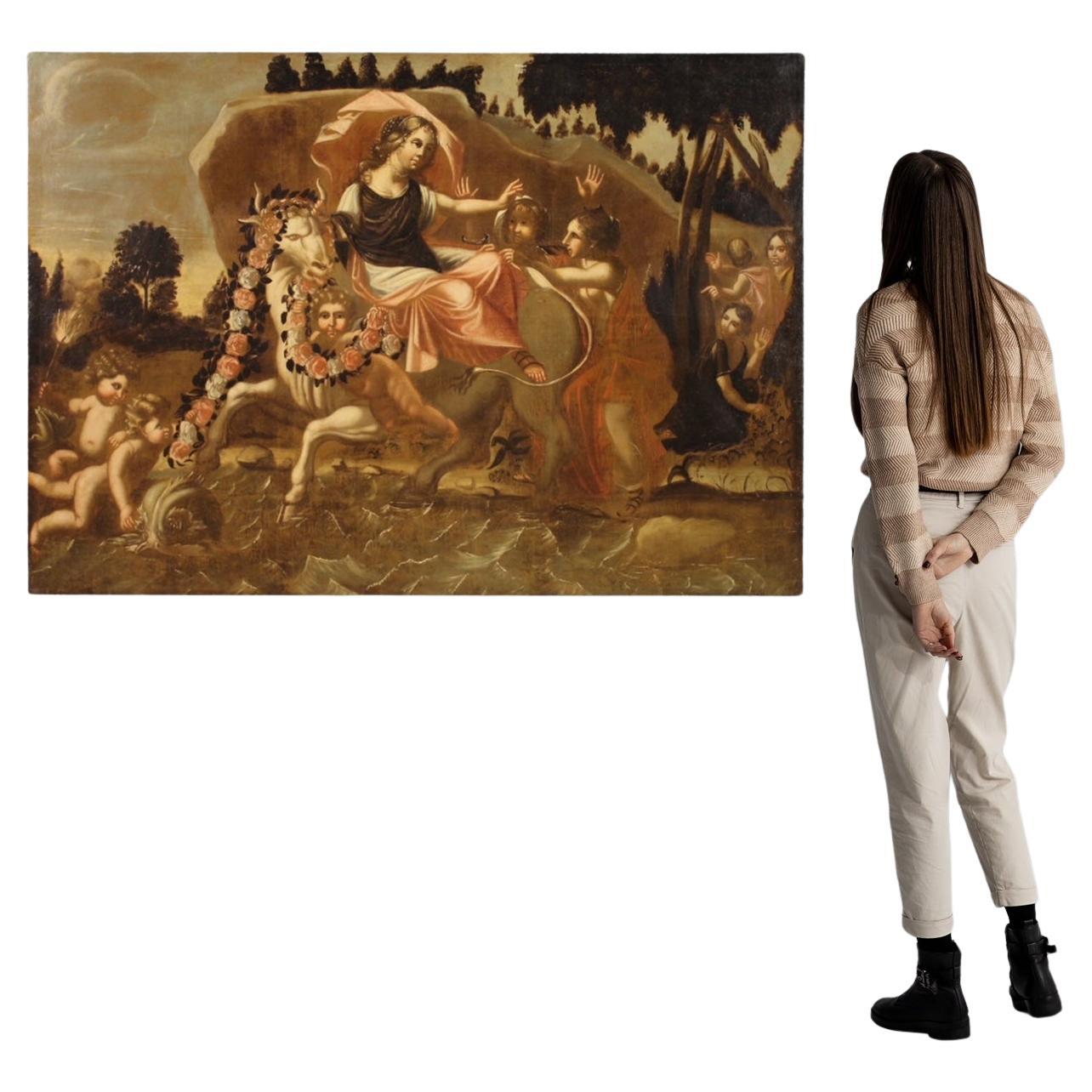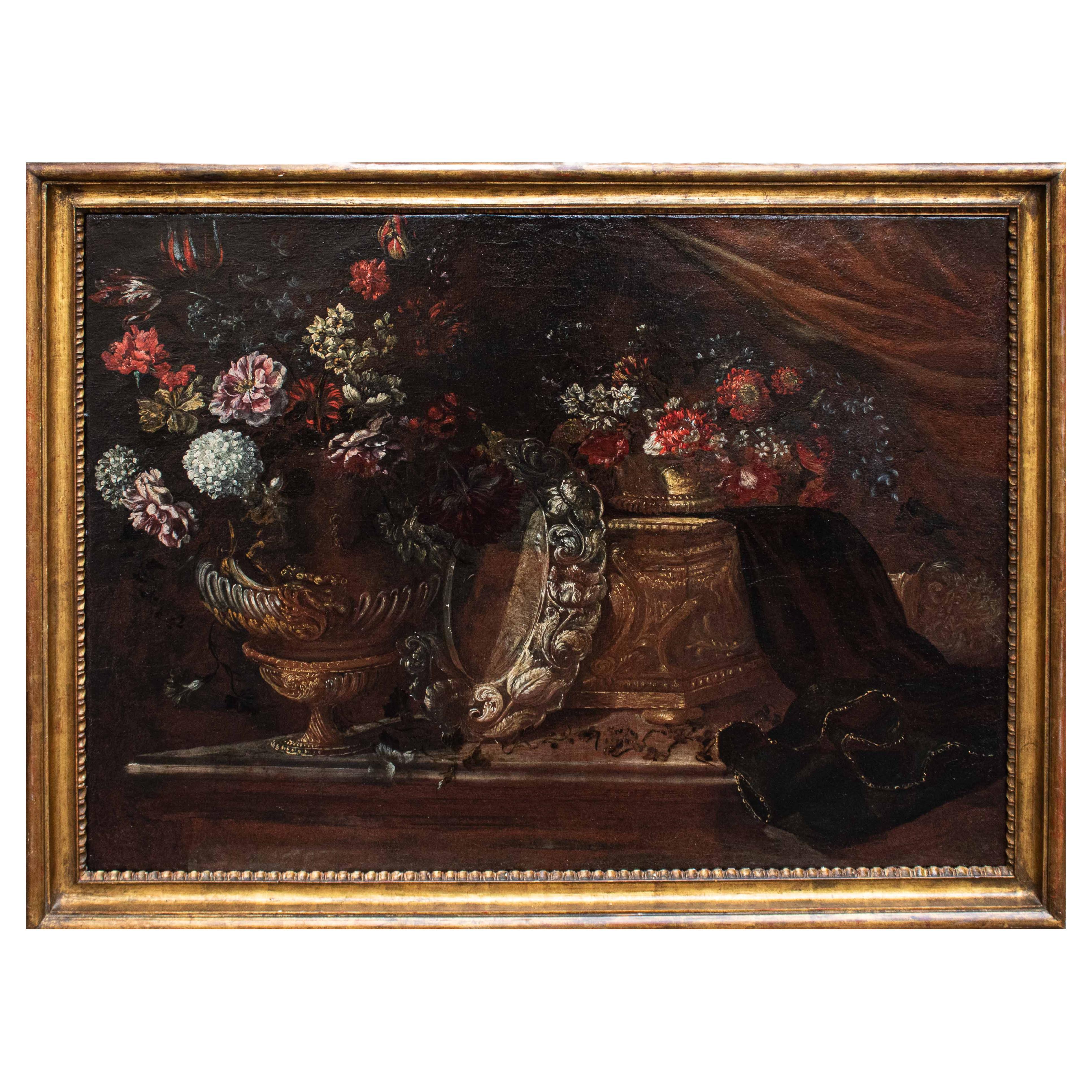Items Similar to 17th century Oil on canvas depicting the Rape of Proserpine
Want more images or videos?
Request additional images or videos from the seller
1 of 21
17th century Oil on canvas depicting the Rape of Proserpine
About the Item
Sienese school of the 17th century
The rat of Proserpina
Oil on canvas, 188 x 123 cm
Depicted at the climax of the action, at the height of drama, is the scene of the Rape of Proserpine ( for the Greeks Persephone) daughter of Ceres. The protagonist of the story is Proserpine, the Roman version of the Greek Persephone, daughter of the agricultural goddess Ceres (Demeter in Greek). These two mythological figures since the beginning of time have been closely linked to the cult of the earth, agriculture and the changing seasons, and, known as the protagonists of the "Eleusinian Mysteries," are also celebrated as "the divine couple." One day, while Proserpina was intent on picking flowers on the shores of Lake Pergusa, near present-day Enna, the underworld god Pluto, known to the Greeks as Hades, became so enamored with her that he decided to kidnap the maiden and take her with him to the realm of the dead. Proserpina's heartbreaking cry for help reached the ears of her mother, who, in despair over the fate of her daughter, wandered nine days and nights, searching for Proserpina throughout Greece and holding two lit torches in her hands. At last Ceres learned from Helios how her Proserpine had been forcibly dragged by Pluto to the afterlife, so, enraged and in grief, she threatened to stop attending to her divine functions until her daughter returned to Earth. She took refuge, therefore, in Eleusis, where she was received with great warmth and hospitality. Meanwhile, however, everything on Earth was beginning to die, and famines began to rage among desperate humans. It was for this reason that Jupiter, concerned about the fate of men, ordered Pluto to let his young bride go free, allowing her to be reunited with her mother. The god of the Underworld agreed, but, reluctant to give up his bride, he cunningly fed Proserpina some pomegranate grains, binding her permanently and forever to the realm of the dead. Ceres and Pluto thus had to give in to a compromise: the young girl would live six months on Earth with her mother and the remaining six months in the Underworld with Hades. During the time spent with Hades, from early autumn (planting time) until the end of winter, cold would reign on Earth and the fields would not bear fruit. At the blossoming of spring, however, Proserpine would be free to return home and Ceres, happy to have her daughter back with her, would give new life, the earth would be fertile and she would feed all men with her crops.
The climax of the action, the moment of abduction, is depicted in the present painting. Pluto, proud and unfeeling, mighty and muscular tries to drag Proserpine into the underworld by force. The God's muscles are tensed in an effort to support the body of the maiden who, though petite, tries to escape and wriggle out of Pluto's tight grip. Behind the god is a glimpse of his horse-drawn chariot from whose mouth flames gush forth, flames that are also found at the feet of the group indicating the inevitable fate of the young woman.
The mythological subject was highly prized by artists who created several versions of it over the centuries, of course the most famous being Bernini's The Rape of Proserpine, contained today in the Borghese Gallery.
- Dimensions:Height: 74.02 in (188 cm)Width: 48.43 in (123 cm)Depth: 1.97 in (5 cm)
- Materials and Techniques:
- Period:
- Date of Manufacture:17th Century
- Condition:Refinished. Wear consistent with age and use.
- Seller Location:Milan, IT
- Reference Number:1stDibs: LU5918237120882

About the Seller
5.0
Vetted Seller
These experienced sellers undergo a comprehensive evaluation by our team of in-house experts.
Established in 2000
1stDibs seller since 2021
25 sales on 1stDibs
Typical response time: 10 hours
- ShippingRetrieving quote...Ships From: Milan, Italy
- Return PolicyA return for this item may be initiated within 14 days of delivery.
More From This SellerView All
- Oil painting on canvas depicting Still life Roman school of the 17th centuryLocated in Milan, ITRoman School, 17th century Still Life Oil on canvas, 79 x 107 cm Framed, 93 x 121 cm The work under scrutiny, depicting a majestic still life of flowers, is ascribed to the 17th...Category
Antique 17th Century Paintings
MaterialsCanvas
- 17th Century Virgin of the Assumption Painting Oil on CanvasLocated in Milan, IT17th century Virgin of the Assumption Oil on canvas, 93 x 81 cm Frame, 110 x 97 cm The present Assumption of the Virgin welcomes an innova...Category
Antique 17th Century Italian Paintings
MaterialsCanvas
- Adoration of the Magi, Oil on canvas, 17th century, Veneto SchoolLocated in Milan, IT17th century, Venetian School Adoration of the Magi Oil on canvas, 48 x 65 cm Framed, 64 x 81 cm The canvas, dating from the 17th century, depicts the Christological theme of th...Category
Antique 17th Century Paintings
MaterialsCanvas
- 17th-18th Century View of the Temple of Minerva Painting Oil on CanvasLocated in Milan, ITPainter active in Rome in the 18th-19th century. View of the temple of Minerva Medica Oil on canvas, 65 x 78 cm - with frame 71.5 x 85 cm The painting bears a traditional attribution to François Marius Granet (Aix-en-Provence, 1775 - 1849). The painter was a pupil of David but from 1802 to 1819 he lived in Rome, as evidenced by a series of paintings depicting views of the city and especially of the Roman countryside (Ponte San Rocco in Tivoli, 1810-20, MoMA, New York), and then return there between 1825 and 1830. In the Eternal City Granet devoted himself to landscape painting, inspired by the landscape painting of Gaspard Dughet and Van Lint...Category
Antique Late 17th Century Italian Paintings
MaterialsCanvas
- 17th Century Annunciation Painting Oil on Canvas Workshop of NuvoloneLocated in Milan, IT17th century, Nuvolone workshop Annunciation Measures: Oil on canvas, 98.50 x 127.00 cm - with frame 144 x 115 Depicted is a canonical Annunciation which sees Mary on her knees ...Category
Antique 17th Century Italian Paintings
MaterialsCanvas
- 17th Century Christ and the Samaritan Oil on Canvas Roman SchoolLocated in Milan, ITRoman school of the 17th century Landscape with bridge - Christ and the Samaritan woman at the well Oil on canvas, cm 42 x 59,5 - With frame, cm 54, 5 x 71 cm The small canvas portrays a broad view of the city surrounded by a bucolic and lush landscape, probably a reinterpretation of the Roman countryside or the Agro. The fulcrum of the canvas is the bridge consisting of several bays beyond which stands a village. In the distance the landscape made of green mountains opens into what looks like a lake crossed by boats. The landscape is animated by the human presence; not only small and fleeting figurines intent on walking along earthy paths but also the representation, in the foreground, of an Gospel episode, that of Christ and the Samaritan woman at the well. The landscape can be clearly traced back to a painter trained on the examples of the great seventeenth-century Roman baroque landscape that sees in the Lunette Aldobrandini by Annibale Carracci but also in Claude Lorrain, Nicolas Poussin and Gaspar Doghet are its greatest achievers. If in the past, therefore, the landscape was considered the scenic background on which to project the representation of divine or human characters, in the seventeenth century it became an autonomous and codified pictorial genre. With Carracci comes the so-called ideal landscape: a mental reconstruction of a peaceful and harmonious nature in which the dream of a perfect communion with man is realized. In the wake of Hannibal, as mentioned, during the seventeenth century the "classic" Roman landscape knows a long and happy season by artists such as Domenichino, and the French Claude Lorrain, Nicolas Poussin and Gaspar Dughet. Lorrain investigates the Roman countryside in all its aspects, studying the variations in the different hours of the day, the seasons or weather conditions, but always nourished by a sense of bucolic Virgilian. With Poussin the approach becomes intellectual elaboration and sophisticated rational construction. From the examples of the great masters, the Roman Baroque season, from the middle of the century, saw the flourishing of several personalities who, with shots, but also important personal reworkings, led to further spread the genre. Among the personalities that can be compared to the work in question we cannot fail to mention Crescenzio Onofri (1634-1714), defined by Salerno as the only true pupil of Dughet, who then spread in Florence the taste of the Baroque landscape influencing Tuscan painters such as Panfi and Peruzzini. His paintings are in various Roman collections; such as, for example, the landscapes from the Sacchetti Collection and today at the Pinacoteca Capitolina. and those in the Almagià collection in Rome, others in the Palazzo di Montecitorio, but the most conspicuous group is in the Galleria Doria. In comparison we can mention the two passages of the National Gallery in London, the landscape with a bridge over the Antiquarian Market but also the design of the National Gallery of Art in Washington. In the work you can also find the influences of the art of Giovanni Francesco Grimaldi...Category
Antique 17th Century Italian Paintings
MaterialsCanvas
You May Also Like
- 17th Century Spanish Oil on Canvas Depicting a QueenLocated in Los Angeles, CAA 17th century Spanish oil painting on canvas depicting a queen witting on a throne with a crown on her head wearing an elaborate costume in brown Gray Red and Beige. She is wearing ...Category
Antique 17th Century Spanish Paintings
MaterialsCanvas
- 17th Century Oil Painting On Canvas Depicting AgonizingLocated in Firenze, ITOil painting on canvas depicting Christ and the Madonna consoling a dying man, Emilian school, 17th century.Category
Antique 17th Century Italian Paintings
MaterialsCanvas
- 17th Century Oil on Canvas Italian Antique Mythological Painting Rape of EuropeLocated in Vicoforte, PiedmontAntique Italian painting from the second half of the 17th century. Artwork oil on canvas depicting the mythological subject Rape of Europa of excellent pictorial quality. Painting of...Category
Antique Mid-17th Century Italian Paintings
MaterialsCanvas
- German 17th-century oil on canvas depicting a Music LessonLocated in Barletta, ITGerman oil on canvas from the 1600s depicting figures in an indoor scene of a music lesson. Attributed to the school of Jacob Lucasz Ochtervelt (1634 - 1682). Comes with a later-peri...Category
Antique 17th Century German Paintings
MaterialsCanvas
- Announcement Italian School Oil on Canvas, of the 17th CenturyBy Europa AntiquesLocated in Madrid, ESAnnouncement Italian School Oil on canvas, of the 17th century Dimension: 75 x 62 cm. Good conditions.Category
Antique 17th Century French Baroque Paintings
MaterialsPaint
- Gathering of Manna, Oil on Canvas, 17th CenturyLocated in Madrid, ESJews in the desert collecting the Manna. Oil on canvas, XVII century. Oil on canvas arranged horizontally in which a figurative theme is shown with a mountainous landscape in the ba...Category
Antique 17th Century Spanish Baroque Paintings
MaterialsOther





